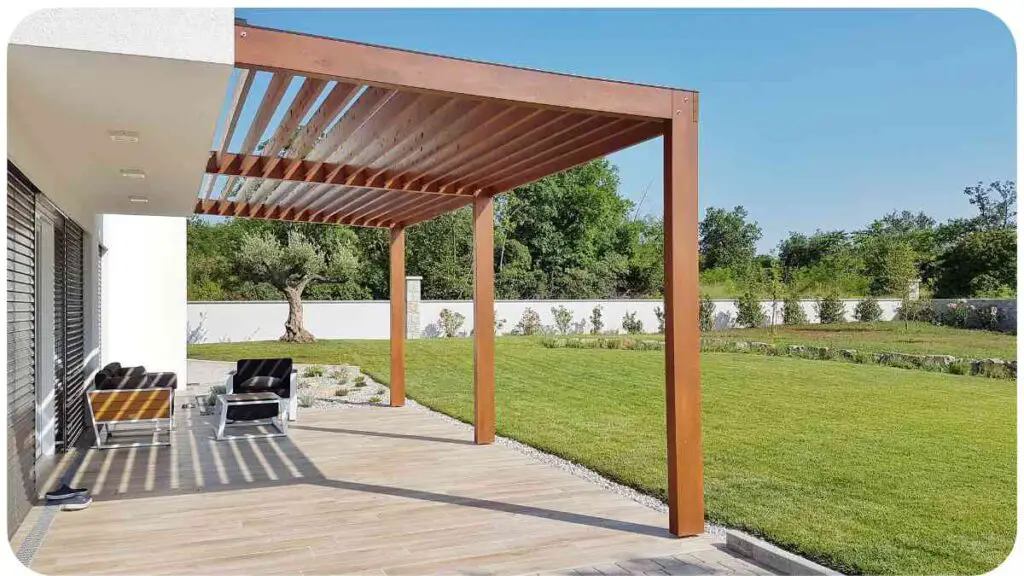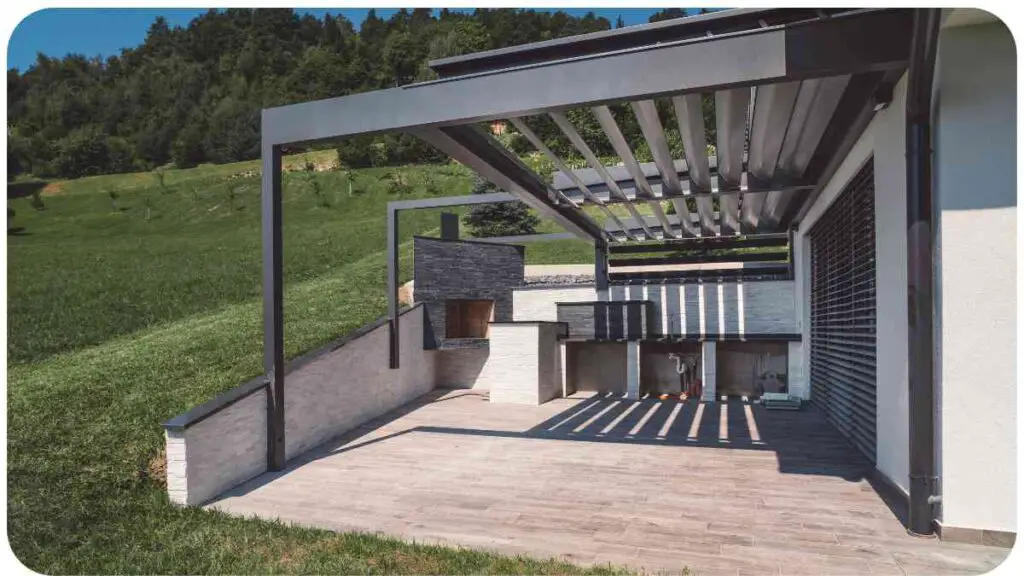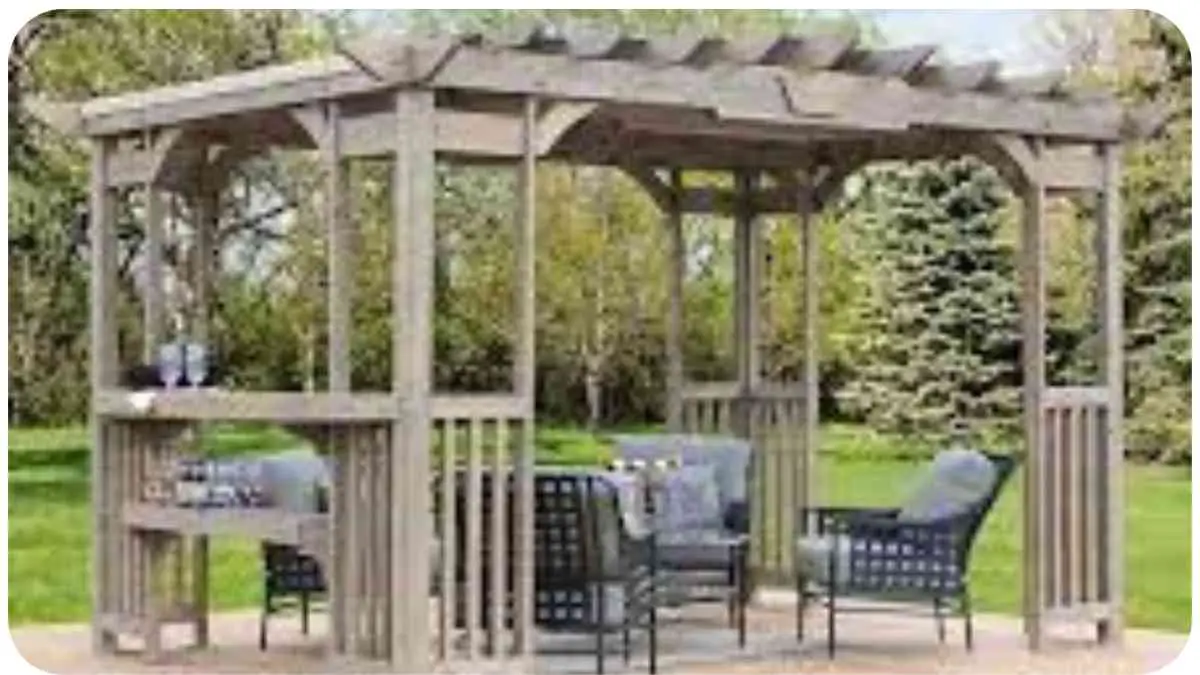Ah, pergolas! Aren’t they the dreamy addition that transforms your backyard into a slice of Mediterranean paradise? When done right, they offer shade, beauty, and a touch of elegance. However, as many have discovered, not all pergolas are created equal. Especially the ones from big-name stores like Home Depot.
| Key Takeaways |
|---|
| The stability of your pergola heavily relies on material choice and foundation type. |
| Environmental factors play a significant role in a pergola’s durability and stability. |
| Regular maintenance can extend your pergola’s life and ensure it remains a safe space. |
| If in doubt, always seek professional advice to ensure the safety and longevity of your pergola. |
| Invest in a sturdy foundation; it’s the base upon which the entire structure stands. |
| Reinforcement methods, like bracing and upgrading fasteners, can enhance stability. |
| Recognizing when to upgrade vs. reinforce is crucial for long-term pergola health. |
| Personal experiences and lessons can provide invaluable insights for pergola upkeep. |
Table: Popular Types of Pergolas
| Type | Primary Material | Pros | Cons |
| Traditional | Wood | Natural Look | Requires Regular Upkeep |
| Modern | Metal/Aluminum | Durable, Sleek Design | Can Get Hot in Sunlight |
| Rustic | Reclaimed Wood | Distinctive Appearance | May Lack Durability |
| Minimalistic | Vinyl | Low Maintenance | May Appear Less Natural |
Common Causes for Pergola Instability

Now, before we get into the specifics of why your Home Depot pergola might be wobbly, let’s take a bird’s eye view. What causes pergolas, in general, to lose their stability? From my years of experience, it’s usually a combination of a few culprits.
Camping by the beach is wonderful, but anchoring your tent securely can be challenging due to shifting sands. Discover effective techniques and tips to ensure a stable tent setup for a hassle-free beach camping experience.
Table: Major Instability Indicators
| Indicator | Possible Cause | Solution |
| Wobbling | Weak foundation | Reinforce or Redo Foundation |
| Creaking sounds | Loose bolts/fasteners | Tighten or Replace Fasteners |
| Visible sagging | Overloading | Distribute Weight or Reinforce Structure |
| Warping of beams | Environmental damage | Use weather-resistant materials |
The Home Depot Pergola: A Closer Look
Home Depot, while a trusted name in many aspects of home improvement, may not be the premier choice for pergolas. Why? Let’s delve into the nuances.
Table: Top Home Depot Pergola Models & Their Specifications
| Model Name | Material | Size | Price Range | User Ratings |
| Hampton Bay | Wood | 10×10 | $$$ | ★★★☆☆ |
| Yardistry | Cedar | 12×12 | $$$$ | ★★★★☆ |
| Sunjoy | Metal | 10×12 | $$ | ★★☆☆☆ |
Inherent Design Flaws
Here’s a thing most of us tend to overlook: Not every design is perfect for every location. Sometimes, pergolas sold by big brands like Home Depot may have design elements that just don’t resonate with particular climatic conditions. For instance, a pergola design ideal for the dry Californian weather might not fare so well in the humid Floridian climate.
Ever found your pergola’s canopy collecting rainwater instead of draining it? Or the latticework failing to provide the right amount of shade? Those, my friends, are design flaws.
Impact of Environmental Factors
Mother Nature, while glorious, can be a bit rough on our beloved pergolas. Prolonged exposure to direct sunlight, rain, snow, or even coastal salt can degrade the materials, especially if they aren’t of the highest quality.
Table: Pergola Failures by Climate Zone
| Climate Zone | Common Issues | Preventative Measures |
| Coastal | Salt damage, rusting | Use rust-proof materials, regular cleaning |
| Tropical | Mold, mildew, rotting | Waterproofing, anti-mold treatments |
| Desert | Sun damage, warping | UV-resistant coatings, reflective materials |
| Temperate | Seasonal wear & tear | Regular maintenance checks, protective sealants |
Substandard Installation Techniques
Remember the excitement when setting up your pergola for the first time? But did you ensure that every bolt was tightened and every post was perfectly vertical? In my personal experiences, while helping friends set up their pergolas, a rushed or subpar installation can spell doom for your pergola’s lifespan.
Camping on concrete surfaces? Learn how to anchor your tent safely and efficiently. Explore various methods and gain insights into using appropriate tools to ensure a stable and comfortable camping environment on solid ground.
Material Quality: It Makes a Difference

It’s tempting to go for a pergola that doesn’t dig deep into our pockets. But, as the saying goes, “you get what you pay for.” A cheaper price tag might indicate inferior materials which might not stand the test of time or the elements.
Table: Comparison of Pergola Materials
| Material | Pros | Cons | Maintenance Frequency |
| Wood | Natural appearance, versatile styles | Susceptible to termites, rot, and UV damage | High |
| Metal | Durable, modern look | Can corrode or rust; gets hot in direct sunlight | Moderate |
| Vinyl | Resistant to rot & pests; low maintenance | May appear plastic-like; can warp in high heat | Low |
| Fiberglass | Lightweight, strong, can mimic wood grains | More expensive; limited design options | Low |
Bolts, Screws, and Fasteners: The Unsung Heroes
Let me share a tidbit from my days working with outdoor structures: the strength of a pergola often lies in its bolts, screws, and fasteners. These tiny components bear the brunt of the structure’s weight and the force of the elements. Using the wrong kind, or not securing them properly, is like building a fortress on sand.
Pergolas offer more than aesthetics—they can create shaded retreats. Understand how pergolas provide shade through design, materials, and strategic placement. Discover practical tips to optimize your pergola’s shade potential, enhancing your outdoor comfort and enjoyment.
Foundation: The Root of Many Problems
Think of the foundation as the shoes for your pergola. Just as you wouldn’t run a marathon in flip-flops, your pergola shouldn’t stand on a weak foundation in harsh weather. From my own encounters, many Home Depot pergola kits come with generic base plates, which might not be the best fit for every ground type.
Table: Types of Pergola Foundations & Their Pros/Cons
| Foundation Type | Pros | Cons |
| Concrete Footings | Extremely stable, long-lasting | Time-consuming to set up, permanent |
| Ground Spikes | Easy installation, good for softer grounds | May not hold well in heavy winds |
| Slab Foundations | Ideal for patios, even weight distribution | Can be costly, requires a flat surface |
| Deck Footings | Perfect for deck installations | Limited to deck areas, may require reinforcement |
Expert Tips to Reinforce Your Pergola
From my years of tinkering and rebuilding, here are some golden nuggets I’ve unearthed:
- Bracing: Adding diagonal braces to the corners can provide extra stability against side-to-side movement.
- Additional Posts: If the span between your pergola posts is too wide, consider adding an additional post or two for added support.
- Upgrading Fasteners: Swap out those generic screws with heavy-duty ones or even consider using galvanized hardware.
Experiencing leaks in your Martha Stewart Living pergola? This guide explains possible reasons for leaks and provides step-by-step instructions to effectively repair and prevent water infiltration, ensuring your outdoor space stays dry and comfortable.
Upgrading vs. Reinforcing: Which is Right for You?
Sometimes, a simple reinforcement might not cut it, especially if your pergola has seen better days. It becomes a weighing scale of cost versus longevity. Upgrading might seem more expensive initially, but in the long run, could save you from repetitive repair costs. On the other hand, a well-maintained pergola might just need a few tweaks here and there.
Professional Assistance: When to Seek It
While I’m all for DIY spirit, there are times when it’s better to leave it to the pros. If you’re unsure about the structural integrity or if the necessary repairs seem overwhelming, it’s best to consult a professional. They can provide insights, tips, and solutions that might not be immediately apparent to the untrained eye.
Maintenance: A Critical Factor
Trust me on this one: Regular maintenance can prolong your pergola’s life by years. From checking for loose fasteners to sealing wood annually, a little care goes a long way.
Table: Recommended Maintenance Schedule
| Task | Frequency | Notes |
| Inspect for loose fasteners | Every 3 months | Tighten or replace as needed |
| Check for wood rot or damage | Bi-annually | Treat, seal, or replace damaged sections |
| Clean canopy or latticework | Annually | Prevents mold and mildew buildup |
| Seal wood components | Annually | Use a UV-resistant sealant for added protection |
Personal Experience: Lessons from the Field
During my time setting up pergolas, one particular incident stands out. A friend bought a beautiful cedar pergola from Home Depot, and within a year, it began to lean ominously.
On closer inspection, it wasn’t the pergola itself but the soil erosion beneath its foundation that was the culprit! We had to dismantle the entire structure, fix the foundation, and then reassemble. The lesson? Always pay attention to the ground you’re building on!
Protect your gazebo from strong winds with these proven techniques and methods. From using anchors to proper placement, this comprehensive guide offers practical solutions to keep your gazebo stable and intact during challenging weather conditions.
Conclusion
The journey of setting up and maintaining a pergola can be likened to nurturing a tree. It requires patience, regular attention, and sometimes, a bit of expert advice. Whether it’s a model from Home Depot or any other provider, the longevity of your pergola heavily rests on the choices made during its installation and subsequent care.
To sum up our discussion:
- Pergolas, while enchanting, come with their set of challenges, especially when it concerns stability.
- Material choice, foundation type, and environmental factors play significant roles in the structure’s longevity.
- Regular maintenance isn’t just recommended; it’s essential.
Table: Final Takeaways
| Key Point | Actionable Insight |
| Material Matters | Opt for high-quality, durable materials. Consider environmental factors when choosing. |
| Foundation is Fundamental | Invest time and resources in setting up a sturdy foundation. Regularly inspect for wear and damage. |
| Regular Maintenance is a Must | Stay proactive. Regular inspections and timely repairs can extend your pergola’s lifespan significantly. |
| Expertise Can Be Invaluable | When in doubt, seek professional advice. Don’t hesitate to invest in expert services if it ensures your pergola’s stability and safety. |
In my years of working with outdoor structures, the most rewarding part has always been seeing a well-maintained pergola stand the test of time, becoming a cherished part of someone’s home. It’s not just about adding a structure to your backyard; it’s about creating memories underneath it.
And with the right care and attention, your pergola can be the shade-bearing sentinel of many cherished moments for years to come.
Further Reading
Best Pergola Reviews
Delve deeper into the world of pergolas with a comprehensive review. This article from WesternSlopeNow gives you a rundown of some of the top-performing pergolas in the market.
Anchoring a Pergola Without Drilling
HansoHome provides a unique guide on how to secure your pergola without the need for drilling. It’s a must-read for those wanting a less invasive anchoring method.
Improving Pergola Stability
Engage with the DIY community on StackExchange in this discussion thread. Here, you can get real-world tips and tricks from fellow pergola enthusiasts on enhancing stability.
FAQs
Why is my Home Depot pergola unstable?
Many factors can contribute to an unstable pergola. It could be due to inherent design flaws, environmental factors, substandard installation techniques, or the quality of materials used.
How can I reinforce my pergola?
You can reinforce your pergola by adding bracing, using additional posts, upgrading fasteners, or seeking professional advice for significant modifications.
What material is best for pergolas in terms of stability?
The “best” material depends on your specific needs and environment. However, wood, metal, vinyl, and fiberglass are popular choices, each with their pros and cons concerning stability and durability.
How often should I maintain my pergola?
Regular maintenance is key. You should inspect for loose fasteners every 3 months, check for wood rot bi-annually, clean the canopy annually, and seal wood components annually.
Can I set up my pergola without professional help?
While many pergolas come with DIY-friendly kits, if you’re unsure about the installation or the structural integrity, it’s always recommended to consult or hire a professional.

I am Hellen James, a professional handywoman with expertise in improving home and garden spaces by using pergolas, gazebos, and tents.


